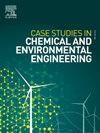Ceramic membranes for winery wastewater management: feasibility study and water reuse potential
Q1 Environmental Science
Case Studies in Chemical and Environmental Engineering
Pub Date : 2025-07-19
DOI:10.1016/j.cscee.2025.101259
引用次数: 0
Abstract
The wine industry faces growing water management challenges due to climate change-induced droughts worldwide. Winery wastewater, with varying organic loads across vintage periods, acidity, phenolic compounds, and trace pesticides, present significant environmental and operational challenges for producers. This study explores winery wastewater reclamation as a sustainable strategy, with ceramic membrane filtration offering a robust and scalable solution. Ultrafiltration (10 nm) was identified at bench-scale as the most effective, reducing chemical oxygen demand by 76 % (from an initial 20–56 mg L−1) and eliminating E. coli, meeting Portuguese reuse standards. For small to medium wineries, a compact unit (2.3 m2 of membrane filtration area) can supply 500 L h−1 of treated water, meeting daily needs for cleaning operations or irrigating up to 3.4 ha of vineyard or green spaces. By reducing freshwater demand, ceramic membranes contribute to enhanced climate resilience and sustainable water management in the wine sector.

陶瓷膜用于酒厂废水管理:可行性研究和水再利用潜力
由于全球气候变化引发的干旱,葡萄酒行业面临着越来越多的水资源管理挑战。酒庄废水在不同年份的有机负荷、酸度、酚类化合物和微量农药等方面存在差异,给生产商带来了重大的环境和运营挑战。本研究探讨了作为可持续战略的酒庄废水回收,陶瓷膜过滤提供了一个强大的和可扩展的解决方案。超滤(10 nm)在实验规模上被确定为最有效的,减少了76%的化学需氧量(从最初的20-56 mg L−1),并消除了大肠杆菌,符合葡萄牙的重复使用标准。对于中小型酿酒厂,一个紧凑的单元(2.3平方米的膜过滤面积)可以提供500 L h−1的处理水,满足清洁操作或灌溉高达3.4公顷的葡萄园或绿地的日常需求。通过减少淡水需求,陶瓷膜有助于提高葡萄酒行业的气候适应能力和可持续水资源管理。
本文章由计算机程序翻译,如有差异,请以英文原文为准。
求助全文
约1分钟内获得全文
求助全文
来源期刊

Case Studies in Chemical and Environmental Engineering
Engineering-Engineering (miscellaneous)
CiteScore
9.20
自引率
0.00%
发文量
103
审稿时长
40 days
 求助内容:
求助内容: 应助结果提醒方式:
应助结果提醒方式:


